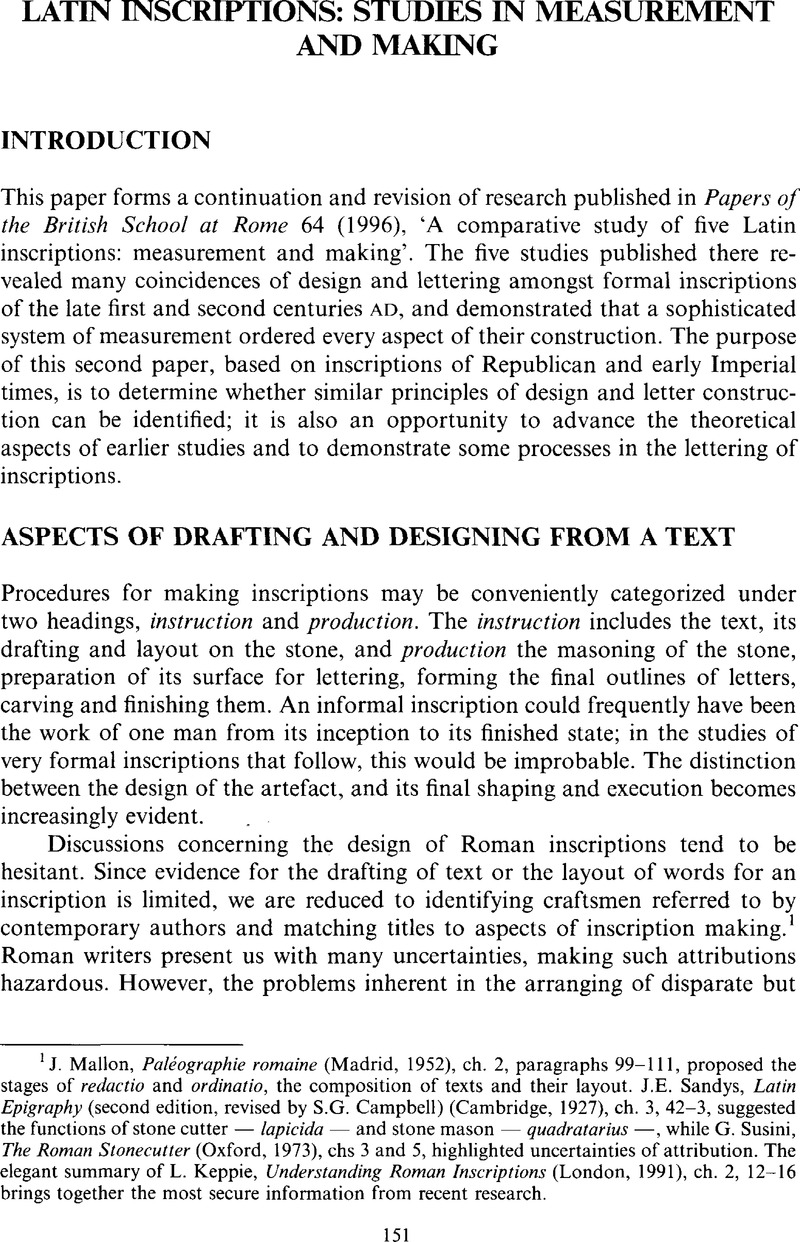Published online by Cambridge University Press: 09 August 2013

1 Mallon, J., Paléographie romaine (Madrid, 1952), ch. 2, paragraphs 99–111Google Scholar, proposed the stages of redactio and ordinatio, the composition of texts and their layout. Sandys, J.E., Latin Epigraphy (second edition, revised by Campbell, S.G.) (Cambridge, 1927), ch. 3, 42–3Google Scholar, suggested the functions of stone cutter — lapicida — and stone mason — quadratarius —, while Susini, G., The Roman Stonecutter (Oxford, 1973)Google Scholar, chs 3 and 5, highlighted uncertainties of attribution. The elegant summary of Keppie, L., Understanding Roman Inscriptions (London, 1991), ch. 2, 12–16Google Scholar brings together the most secure information from recent research.
2 Pinker, S., How the Mind Works (London, 1997), ch. 4, 284–7Google Scholar, has explained the incarnation of a dimensional sketch in neurons as a topographically organized cortical map, fifteen of which have been identified in the primate brain ‘creating pictures in the head’.
3 Oxyrhynchus Papyrus 2950 (Browne, G.M., Coles, R.A., Rea, J.R., Shelton, J.C. and Turner, E.G., The Oxyrhynchus Papyri XLI (London, 1972))Google Scholar is suggested to be a mason's rough for cutting an inscription or an ephemeral poster, the latter being more probable. This large sheet would be no more useful to the ordinator than a draft written in cursive capitals on a small wax tablet.
4 Mallon, Paléographie romaine (above, n. 1), paragraph 105.
5 Catich, E.M., The Origin of the Serif (Iowa, 1968), 215–19 and 279Google Scholar, advocated ‘the supremacy of writing’, inscriptions being lettered without recourse to any but the most rudimentary constructional marks.
6 Henig, M. (ed.), A Handbook of Roman Art (London, 1983)Google Scholar. Contributors describe processes behind sculpture, painting, mosaics, building and architectural design, many of which have relevance to the making of inscriptions.
7 The plan of the Ionic Temple of Athena Polias is one of the first to be based on the uniform grid: Coulton, J.J., Greek Architects at Work (London, 1997), 70–1Google Scholar. This became a principle of temple design from the fourth century onwards. Coulton noted among the minor duties of the architekton ‘arranging for the writing of inscriptions, indicating where they might be set up’.
8 Austin, R.P., The Stoichedon Style in Greek Inscription (Oxford, 1938), ch. 4, 24–7Google Scholar.
9 Anderson, W.J., The Architecture of Ancient Rome (London, 1927), ch. 3, 26–42Google Scholar.
10 Morgan, M.H., Vitruvius, the Ten Books of Architecture (New York, 1960), 206Google Scholar.
11 R. Ireland, ‘Epigraphy’, in Henig, Handbook of Roman Art (above, n. 6), 221–33, traced epigraphic developments in the Roman world and identified the writing styles.
12 Grasby, R.D., ‘A comparative study of five Latin inscriptions; measurement and making’, Papers of the British School at Rome 64 (1996): Study 5: RIB 288, pp. 115–27CrossRefGoogle Scholar.
13 Similar attention is given to the centering on the V of DIVI in Study 2: RIB 330 and the I of CAESARI in Study 3: CIL XIV 86 (Papers of the British School at Rome 64: 107 and 110) and is observable, without measurement, on many other inscriptions.
14 Erratum: This inscription, Study 1 in Papers of the British School at Rome 64, is there referenced incorrectly as CIL VI 690. The correct reference is CIL VI 960.
15 T. Perkins, The Edge (January 1997), 11–15, identified the root-five rectangle and the golden rectangle as proportions observable in some letters of CIL VI 960. Having constructed these rectangles within a square, a third rectangle is revealed of ratio 1:10. This provides the proportions of the letter stem. An attempt has been made to apply proportional rectangles to letters of stem ratio 1:8 in Font. Summer Stone, Calligraphy and Type Design in a Digital Age (Ditchling Museum, 2000), 35–50, without proposing a satisfactory structural geometry for them.
16 Hambidge, J., The Elements of Dynamic Symmetry (New York, 1967)Google Scholar.
17 See Keppie, Understanding Roman Inscriptions (above, n. 1), figs 24 and 54. Also Ireland, ‘Epigraphy’ (above, n. 11), figs 192 and 227. Described as scriptura actuaria, a distinction should be drawn between letters made with the brush edge at 30° to the writing line and those made at a steeper angle, generally characterized as rustica, the smaller letters in both illustrations.
18 Catich, The Origin of the Serif (above, n. 5), 220–1.
19 See Papers of the British School at Rome 64 (1996): 118–19Google Scholar, figs 22 and 23.
20 Fine sgraffito work is found on Athenian black and red figure pottery of the sixth century BC. The stylus cuts through the applied surface colour to reveal the clay body below; even accepting shrinkage during firing, the stylus lines are exceptionally fine, perhaps 0.1 mm. The black figure amphora, Ashmolean Museum, 1965.131, is one of many handsome examples.
21 See Papers of the British School at Rome 64 (1996): 132–4Google Scholar. As a process in the reconstruction of Study 2, RIB 330, a wash of clay coloured with ochre was applied to the marble. Figure 37 in that article shows bot h the contrast between painted letter and chisel cut, and also between cut letter and background.